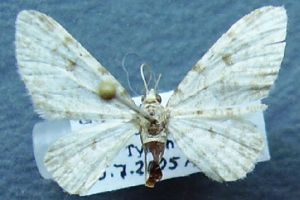

 +2Kontinente:EUAS
+2Kontinente:EUAS2. Diagnose
2.1. Falter
3. Weitere Informationen
3.1. Synonyme
- Eupithecia nachadira sensu auct. europ. nec Brandt, 1941
3.2. Taxonomie
Mironov (2001: 27) beschrieb E. mandarinca nach einem einzigen Weibchen, das 1924 im Süden der Krim (Ukraine) gefangen wurde. Schon bald danach (Mironov (2003: 242-244) synonymisierte er seine neue Art mit Eupithecia nachadira und erläuterte: "The adults of E. nachadira, including lectotype and paralectotype, were examined and compared with holotype of E. mandarinca from Crimea. There were no morphological differences or differences in wing colour and maculation between both these species." Die aus dem Iran beschriebene Eupithecia nachadira wurde so zur europäischen Art. Doch dabei blieb es nicht: Müller et al. (2019: 553) befreien E. mandarinca wieder aus der Synonymie und erläutern: "Recorded for the fauna of Europe under the Name of E. nachadira in GME4 (Mironov 2003, number 107), with the taxon Eupithecia mandarinca Mironov, 2001 listed as a Junior synonym. The latter, however now again raised from synonymy and validated at species rank (V. Mironov pers. comm.), the European records (Crimea) thus referring to Eupithecia mandarinca." Gründe für diese erneute Änderung werden leider nicht genannt.
3.3. Faunistik
Locus typicus ist Karadagh in der südlichen Krim (Ukraine). Die Art ist aus Europa bisher nur von der südlichen Krim bekannt. Nach Müller et al. (2019: 553) gehört auch das Tier von Mironov (2003: pl. 11, fig. 107 c) mit Fundort Keredj - Chalus im Nord-Iran zu E. mandarinca, so dass Eupithecia nachadira erst im Süd-Iran auftritt.
(Autor: Erwin Rennwald)
3.4. Literatur
- Brandt, W. (1941): Beitrag zur Lepidopteren-Fauna von Iran (4). Einige neue Geometriden. — Mitteilungen der Münchner Entomologischen Gesellschaft 31: 864-886, pl. XXVIII-XXX. — Digitalisat auf www.archive.org: [877], [pl. XXIX].
- Erstbeschreibung: Mironov, V. (2001): New and scarce European Eupithecia species (Geometridae. — Nota Lepidopterologica 24 (1/2): 21-28. [Digitalisat auf biodiversitylibrary.org]
- Mironov, V. (2003): Larentiinae II (Perizomini and Eupitheciini). — In: Hausmann, A. (Hrsg.): The Geometrid Moths of Europe 4: 1-463.
- Müller, B., Erlacher, S., Hausmann, A., Rajaei, H., Sihvonen, P. & P. Skou (2019): The Geometrid Moths of Europe. Volume 6. Subfamily Ennominae II (Boarmiini, Gnophini, additions to previous volumes). — Part 1: 1-562, part 2: 563-906. Leiden & Boston (Brill).





